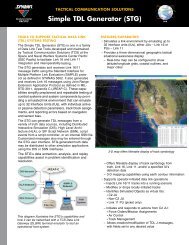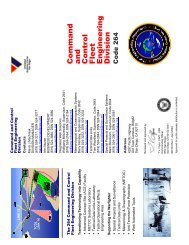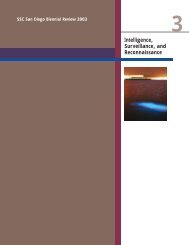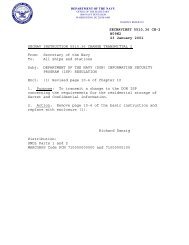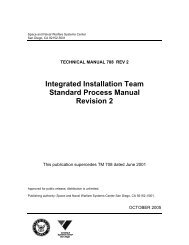Systems Integration Facility: Past, Present, and Future - Spawar
Systems Integration Facility: Past, Present, and Future - Spawar
Systems Integration Facility: Past, Present, and Future - Spawar
Create successful ePaper yourself
Turn your PDF publications into a flip-book with our unique Google optimized e-Paper software.
156<br />
C 4 ISR SYSTEMS INTEGRATION AND INTEROPERABILITY<br />
of sight by using one or more<br />
members of the net, or any Link-<br />
16 terminal, as relays.<br />
When the Navy JTIDS developmental<br />
test program was established<br />
to verify the technical<br />
adequacy of the JTIDS terminal<br />
<strong>and</strong> the integration of Link-16<br />
into designated Navy host combat<br />
platforms, a l<strong>and</strong>-based laboratory<br />
environment for terminal<br />
specification testing <strong>and</strong> multiplatformintegration/interoperability<br />
testing was needed as a<br />
cost-effective precursor to live<br />
platform testing <strong>and</strong> to allow<br />
problem resolution.<br />
The SIF was designed to utilize a<br />
complex multi-computer simulator/<br />
stimulator connected to eight<br />
JTIDS terminals linked together<br />
by an RF network that introduced<br />
propagation delays <strong>and</strong><br />
attenuation into tactical message<br />
traffic. The test bed also included external communications equipment, an<br />
antenna, test scripting, data storage, reduction, <strong>and</strong> analysis equipment,<br />
<strong>and</strong> various interfaces.<br />
By September 1991, the SIF provided a fully integrated multi-platform<br />
functional testing capability. The SIF/Combined Test Bed (CTB) used<br />
intermediate processors to tie together the SIF <strong>and</strong> the Combat Direction<br />
System Development <strong>and</strong> Evaluation Site (CDES) laboratory in the same<br />
building, the E-2C Software Support Activity (SSA) laboratory in<br />
Building C-60, <strong>and</strong> the F-14D Mission Computer Subsystems Software<br />
Development Laboratory at Pt. Mugu, California. The CDES contains<br />
shipboard combat system configurations <strong>and</strong> programs for testing CV,<br />
LHD, Aegis CG/DDG, <strong>and</strong> LHA platforms. It also serves as the primary<br />
development <strong>and</strong> testing laboratory for the C2 FUTURA<br />
The early SIF. Many of the original components of the <strong>Systems</strong> <strong>Integration</strong> <strong>Facility</strong> shown<br />
in this 1992 photo have since been replaced by "New SIF" distributed components hosted<br />
on personal computers, enabling an infinite number of system configurations that can be<br />
tailored to support a large number of test <strong>and</strong> training scenarios.<br />
P. The E-2C laboratory<br />
consists of actual E-2C Airborne Tactical Data System (ATDS) software<br />
<strong>and</strong> hardware components. The F-14D facility consists of actual F-14D<br />
software <strong>and</strong> hardware components.<br />
By early 1993, the CTB was extended to the Aegis Combat <strong>Systems</strong><br />
Center, Wallops Isl<strong>and</strong>, Virginia, for testing <strong>and</strong> integrating Aegis combat<br />
systems. Later, to support developmental testing of the new generation of<br />
Link-16 terminals, the Multifunctional Information Distribution System<br />
(MIDS), the F/A-18 Advanced Weapons Laboratory at the Naval Air<br />
Warfare Center, China Lake, California, was added to the CTB.<br />
The SIF is the central node of the CTB, providing a central script controller<br />
to run the test information <strong>and</strong> direct it to real or simulated host<br />
systems that control the appropriate terminal type in the SIF terminal<br />
farm. The unique JTIDS RF simulation environment in the SIF provides<br />
connectivity between the SIF terminals, with digital propagation delays<br />
<strong>and</strong> attenuation matched to a scripted scenario. To support exercises that<br />
require live transmission rather than SIF RF network simulations, two



